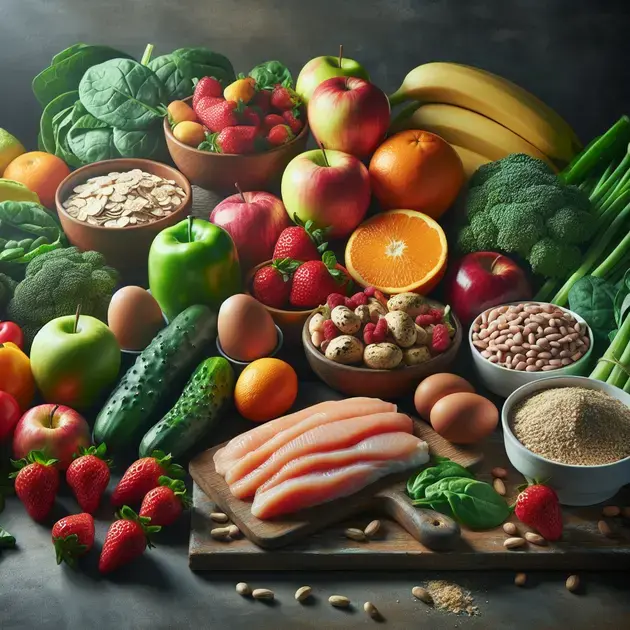If you’re looking to lower your sugar naturally, you’re not alone. Recent studies indicate that excessive sugar intake is linked to various health issues, including diabetes, obesity, and heart disease. Making a conscious effort to reduce your sugar intake can lead to significant health benefits. This article outlines simple steps to help you cut down on sugar without compromising on taste or nutrition.
Understanding where sugar hides in your diet is the first step towards making healthier choices. It’s not just about cutting back on sweets; sugar can be found in numerous products where you might not expect it, such as bread, cereals, and even salad dressings. Learning to read labels effectively and opting for natural, unprocessed foods can dramatically decrease your sugar consumption and enhance your overall health.

Identifying Hidden Sugars in Your Diet
When aiming to lower your sugar intake, it’s important to understand where hidden sugars may be lurking in your diet. Reading food labels is crucial in identifying these hidden sugars, as they can often be disguised under different names such as sucrose, fructose, or corn syrup. One helpful tip is to focus on the ingredient list rather than just the total sugar content, as some products may contain natural sugars from fruits or dairy, which are not as concerning as added sugars.
Another strategy to identify hidden sugars is to make use of smartphone apps such as “MyFitnessPal” or “Fooducate.” These apps allow you to track your daily food intake and provide detailed information about the sugar content of various foods. By logging everything you eat and drink, you can easily spot sources of hidden sugars and make more informed choices about your diet.
In addition to food labels and apps, you can also educate yourself about common sources of hidden sugars. For example, condiments like ketchup, salad dressing, and barbecue sauce often contain added sugars. Similarly, processed foods such as granola bars, flavored yogurt, and canned soups can be high in hidden sugars. By familiarizing yourself with these sources, you can be more mindful when selecting foods and beverages.
One practical step you can take to identify hidden sugars is to prepare more homemade meals and snacks. By cooking at home, you have full control over the ingredients you use and can avoid hidden sugars found in takeout or packaged foods. Websites like “AllRecipes” or “Epicurious” offer a wide range of low-sugar recipes for you to try, empowering you to make healthier choices in the kitchen.
Lastly, don’t overlook the importance of keeping a food journal to track your sugar intake. Writing down everything you eat and drink throughout the day can help you spot patterns, identify sources of hidden sugars, and make adjustments to your diet accordingly. Whether using a physical notebook or a digital journaling app like “Day One,” this practice can be a valuable tool in your journey to reduce sugar intake.
Opting for Natural, Unprocessed Foods
One effective way to lower your sugar intake naturally is to prioritize natural, unprocessed foods in your diet. Whole foods such as fruits, vegetables, lean proteins, and whole grains are inherently lower in added sugars compared to processed foods. By incorporating more of these foods into your meals, you can reduce your overall sugar consumption and improve your nutritional intake.
Start by setting a goal to fill half your plate with fruits and vegetables at each meal. Websites like “ChooseMyPlate.gov” provide visual guides on building a healthy plate, emphasizing the importance of variety and color. By focusing on whole, plant-based foods, you can enhance the nutritional quality of your diet while reducing your sugar intake.
Another key step in opting for natural, unprocessed foods is to limit your consumption of sugary beverages. Instead of reaching for soda, sports drinks, or sweetened teas, opt for water, herbal teas, or infused water flavored with fresh fruits and herbs. Apps like “Plant Nanny” can help you track your water intake and encourage you to stay hydrated throughout the day.
When shopping for groceries, prioritize the perimeter of the store where fresh produce, lean meats, and dairy products are typically located. By steering clear of the inner aisles with processed and sugary foods, you can avoid temptations and make healthier choices for you and your family. Online platforms like “Thrive Market” offer a convenient way to order natural and organic products for delivery to your doorstep.
Lastly, consider joining a community-supported agriculture (CSA) program or visiting local farmers’ markets to access fresh, seasonal produce. By connecting directly with farmers and choosing locally grown foods, you can support sustainable agriculture practices and enjoy the benefits of nutrient-rich, unprocessed ingredients in your meals. Websites like “LocalHarvest” provide resources for finding CSAs and farmers’ markets in your area.

Identifying Hidden Sugars in Your Diet
When it comes to maintaining a healthy diet, one of the biggest challenges is identifying hidden sugars in the foods we eat. Sugar can often be disguised under different names in ingredient lists, making it difficult to spot. One way to tackle this issue is to carefully read food labels and familiarize yourself with the various terms that are used to refer to sugar. Look out for words like sucrose, glucose, fructose, and high fructose corn syrup, among others. By being aware of these hidden sugars, you can make more informed decisions about the foods you consume.
Another tip for identifying hidden sugars is to choose whole, unprocessed foods whenever possible. Fruits, vegetables, lean proteins, and whole grains are all great options that are naturally low in added sugars. By opting for these foods, you can reduce your overall sugar intake and improve your overall health. When shopping for groceries, focus on the perimeter of the store where you can find fresh, whole foods, and minimize your trips down the aisles where processed foods with hidden sugars are usually located.
It’s also important to be mindful of the beverages you consume, as many drinks are loaded with hidden sugars. Soda, fruit juices, energy drinks, and flavored coffees are often packed with added sugars that can contribute to weight gain and other health issues. Instead, opt for water, herbal teas, or homemade smoothies made with natural ingredients. By making these simple swaps, you can significantly reduce your sugar intake and improve your overall well-being.
In addition to reading labels and choosing unprocessed foods, consider cooking and preparing your meals at home as much as possible. When you cook your own meals, you have full control over the ingredients you use and can avoid hidden sugars that are commonly found in restaurant and pre-packaged foods. Experiment with different herbs and spices to enhance the flavor of your dishes without relying on added sugars. By taking charge of your food preparation, you can enjoy delicious meals while keeping your sugar intake in check.
By taking proactive steps to identify and reduce hidden sugars in your diet, you can improve your overall health and well-being. Start by familiarizing yourself with common terms for sugar, choosing whole foods, being mindful of your beverage choices, and taking control of your meal preparation. With dedication and awareness, you can make positive changes to your diet that will benefit your health in the long run.
Opting for Natural, Unprocessed Foods
One of the best ways to reduce your sugar intake and improve your health is by opting for natural, unprocessed foods. These foods are not only free of added sugars but also rich in nutrients that support overall well-being. When you choose whole foods like fruits, vegetables, whole grains, and lean proteins, you can enjoy a balanced diet that nourishes your body without the harmful effects of excess sugar.
Whole fruits are an excellent choice for satisfying your sweet cravings without consuming added sugars. Fruits like berries, apples, and oranges are naturally sweet and packed with vitamins, minerals, and fiber that are essential for good health. Incorporate a variety of fruits into your diet to enjoy a range of flavors and nutrients while keeping your sugar intake in check.
Vegetables are another key component of a natural, unprocessed diet. Vegetables are low in calories and sugar but high in essential nutrients that promote optimal health. Leafy greens, cruciferous vegetables, and colorful peppers are all great options to include in your meals. Experiment with different cooking methods like roasting, grilling, or steaming to enhance the natural flavors of vegetables without the need for added sugars.
When it comes to grains, choose whole grains like quinoa, brown rice, and oats over refined grains like white bread and pasta. Whole grains are rich in fiber and nutrients, providing sustained energy and keeping you feeling full longer. By opting for natural, unprocessed grains, you can avoid hidden sugars commonly found in processed grain products and support your overall health and well-being.
Incorporating lean proteins like chicken, fish, tofu, and legumes into your diet is another way to enjoy natural, unprocessed foods that are free of added sugars. Protein is essential for building and repairing tissues in the body and plays a key role in maintaining muscle mass, supporting immune function, and promoting satiety. By including a variety of lean protein sources in your meals, you can support your overall health goals while reducing your sugar intake.
Conclusão
Identifying hidden sugars in your diet is essential for maintaining a healthy lifestyle. By familiarizing yourself with the various terms used to describe sugar and carefully reading food labels, you can make informed decisions about the foods you consume. Opting for whole, unprocessed foods like fruits, vegetables, lean proteins, and whole grains can significantly reduce your sugar intake and improve your overall health. Choosing natural, unprocessed foods not only helps in avoiding added sugars but also provides essential nutrients that support your well-being.
When it comes to satisfying sweet cravings, whole fruits are a great alternative to foods with added sugars. Fruits like berries, apples, and oranges are not only naturally sweet but also rich in vitamins, minerals, and fiber. Including a variety of fruits in your diet can offer a range of flavors and nutrients while keeping your sugar intake in check. Additionally, incorporating vegetables into your meals, such as leafy greens, cruciferous vegetables, and colorful peppers, provides essential nutrients without the need for added sugars.
Choosing whole grains over refined grains, such as quinoa, brown rice, and oats, can further help in reducing hidden sugars in your diet. Whole grains are packed with fiber and nutrients that offer sustained energy and keep you feeling full longer. Furthermore, including lean proteins like chicken, fish, tofu, and legumes in your meals supports muscle maintenance, immune function, and satiety without the addition of sugars. By making these simple yet impactful dietary choices, you can effectively manage your sugar intake and prioritize your overall health and well-being.
